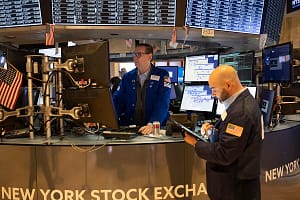US bond ETFs continued their remarkable recovery at the beginning of the new month. This coincided with the Federal Reserve’s announcement of its decision on the interest rate, which came as the markets had widely expected, to keep the current rates as they are.
While the focus was on Jerome Powell’s speech following the announcement of the decision.
The speech does not seem to have brought anything new, as the Fed Chairman stressed the need to be careful in making the decision to raise interest rates in light of the current uncertainty. He also indicated that progress in combating inflation is not sufficient until now, meaning that the Fed wants to keep the door open for further interest rate hikes if necessary.
On the other hand, the markets do not seem to believe in the possibility of the Fed raising interest rates again. I also see, as it is being talked about, that if the Fed does not raise interest rates at the last meeting this year, it may already have finished the hiking cycle. While the markets seem to really believe that, i.e., no further interest rate hike, and this is what the markets seem to believe since the Fed began halting the hiking cycle.
This narrative seems to have reinforced the markets’ hypothesis that bond ETFs, specifically US Treasury bond ETFs, have reached their bottom and may actually begin their awaited bullish trend. This is what we actually saw even before the Fed announced its latest decision. Last October witnessed more record inflows towards bond ETFs.
Bond ETFs that focus on US Treasuries and government bonds recorded net inflows of more than $15 billion during last October alone, the largest number since last March, for a sample of 14 of the largest of these ETFs. Accordingly, these ETFs are heading towards completing a full year of positive net flows, with more than $90 billion since the beginning of the year.
ETFs focusing on short-term bonds accounted for the largest portion of these flows, with more than $9.8 billion. While the SPDR Bloomberg 1-3 Month T-Bill ETF (BIL) had the largest share of these flows, about $6 billion in positive net flows, which is the highest since September of 2022.
The ETF focuses on shorter-term Treasury bills that extend for three months at most, which recorded the highest record yields that we have not seen since the beginning of the new millennium, close to 5.5%. It seems that investors are taking advantage of these record yields, which exceed the yields even on 20- or 30-year bonds, which are at 5% or slightly less.
ETFs focusing on long-term bonds also recorded more positive net flows last month, with about $3.8 billion for four of the largest ETFs. While the iShares 20+ Year Treasury Bond ETF (TLT) accounted for most of these net flows, with more than $2.9 billion, it has thus recorded more than $20 billion in positive net flows since the beginning of the year.
This is after the ETF attracted attention by being among the worst performing bond ETFs in the market, as it lost more than 54% from its highest levels recorded in the year 2020 and reached its lowest levels since 2007.
As for ETFs that focus on tracking the performance of the wider bond market, they continued to record positive flows during the past month. Four of the most prominent ETFs recorded net flows of more than $1.9 billion in total. While the Vanguard Total Bond Market ETF (BND) accounted for more than 1.2 billion of these net flows, which is the eleventh consecutive month of positive net flows.
It seems that investors are focusing on short-term bond ETFs rather than long-term and hybrid ones. This appears to be due to the unclear vision of the long-term future of the US economy, which is an important factor in influencing long-term bonds performance, while short-term bonds are usually influenced by the interest rate set by the Federal Reserve and its expectations, which seem clearer to the markets at the present time, i.e., the tendency is not to raise them again anymore, which helps determine the where is bottom of the ETFs that focus on these bonds.
However, in general, we see more positive sentiment continuing to flow in light of the latest numbers, in addition to a decline in uncertainty in bond markets. The Merrill Lynch Option Volatility Estimate (MOVE), which is used as an indicator of fear in bond markets based on the options associated with them, fell to its lowest levels in a month, which may reflect more investor certainty about interest rate trends.
These positive net flows come at the expense of more net negative flows into international funds and inflation-protected securities (TIPS).
Two major international bond funds, the Vanguard Total International Bond ETF (BNDX) and the iShares J.P. Morgan USD Emerging Markets Bond ETF (EMB) saw more net outflows last month, with a total of about $1.4 billion.
Meanwhile, the markets do not appear to be enthusiastic enough to invest in non-US bonds, which may offer higher yields sometimes, due to the lack of confidence in the future of the global economy, including the European economy, which is still suffering from a continued decline in manufacturing and services activities and weakness in the labor market, as we saw in a latest economic data.
Speaking of outflows as well, funds that focus on inflation-protected bonds continued to record net outflows for the eleventh consecutive month at more than $1.2 billion for four of the most prominent ETFs.
It is clear that markets believe that inflation is already on track and will not return to the previous exceptional highs. While geopolitical tensions and conflicts taking place outside the US territory may threaten this hypothesis if they worsen, which could cause a return of disturbances to global supply chains, most notably energy supplies.
Look at the following chart, which illustrates the net flows to the previously mentioned bond ETFs during last October:

Source: ETF.com
Not far from bond ETFs, and also speaking of negative net flows, gold ETFs witnessed more massive net outflows last October for the fifth month in a row.
The largest physical gold ETFs, the iShares Gold Trust (GLD) and the iShares Gold Trust (IAU), recorded net negative flows of approximately $1.4 billion in total during the past month, thus bringing net outflows to more than $6 billion since the beginning of the year.
Look at the following chart, which illustrates the net flows of the previous two ETFs since the beginning of the year:

Source: ETF.com
Meanwhile, investors continue to leave gold ETFs despite the record levels of the yellow metal, which exceeded the level of $2,000 per ounce late last month. Gold is trying to take advantage of growing concerns about the possibility of the ongoing conflict in the Middle East spiraling out of control to include countries outside the region’s borders, which could harm US interests and global supply chains.
Gold also seeks, as usual, to benefit from expectations of the end of the monetary tightening cycle in the US. Yes, this may seem justified with expectations that the interest rate could be cut sometime next year.
However, expectations and the Federal Reserve’s repeated talk about the possibility of the current record high interest rates remaining at their levels for a longer period than expected during the coming year may continue to encourage investors to invest in yield-generating bonds, with their record high yield, instead of gold. That is, investors in bonds now may enjoy relatively high yields for a relatively long time.
Moreover, despite the continuing escalation of military actions in the Middle East, I see a contrary tendency from the international influencing countries to contain the conflict or at least keep it within its current borders.
As the global economy has suffered a lot since the outbreak of the COVID-19 epidemic and the war in Eastern Europe, and the subsequent rise in inflation and interest rates and the decline in economic activities, and therefore they will not prefer or be able to even enter into new conflicts that may be broader in its scope.
Therefore, I believe that no matter how much gold tries to rise and regain its rank as the first safe haven in cases of uncertainty, we will find gold short sellers lurking in the shadow, waiting for the appropriate opportunity to enter and push gold to fall violently, by taking advantage of the negative factors that we mentioned above.
As such, I don’t see anything that would support sustainable gains for gold, and that’s what sellers might think as well. At least for now.






Leave a Comment